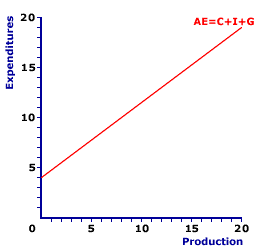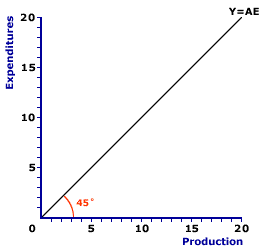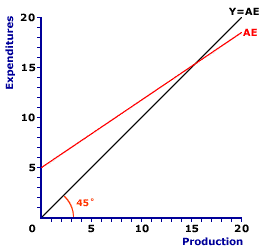
|
|
AGGREGATE EXPENDITURE EQUATION: An equation indicating that aggregate expenditures (AE) are the sum of consumption expenditures (C), investment expenditures (I), government purchases (G), and net exports (X-M), stated as: AE = C + I + G + (X-M). This equation surfaces in the Keynesian economic income-expenditure model in the form of the aggregate expenditures line. However, it's also central throughout the study of macroeconomics, including aggregate demand and the measurement of gross domestic product.
Visit the GLOSS*arama
|
|


|

|
                           FOUR-SECTOR KEYNESIAN MODEL: A Keynesian model of the macroeconomy that includes all four macroeconomic sectors, the household sector, the business sector, the government sector, and the foreign sector. This Keynesian model variation adds the foreign to the three domestic sectors (household, business, and government) in the three-sector model. This model provides the complete Keynesian representation of the macroeconomy, including the export-import interaction between the domestic economy and the foreign sector. Equilibrium is identified as the intersection between the C + I + G + (X - M) line and the 45-degree line. Two related variations are the two-sector Keynesian model and the three-sector Keynesian model. The four-sector Keynesian model is the complete Keynesian model, containing all four macroeconomic sectors--household, business, government, and foreign. It adds the foreign sector to the three domestic sectors, thus including the role of foreign trade, or net exports, in the analysis of equilibrium. Including the foreign sector is a simple matter of adding another layer--net exports--onto the aggregate expenditures stack of the three-sector Keynesian model.The Foreign SectorThe four-sector Keynesian model adds the foreign sector to the three-sector model containing the household, business, and government sectors. The foreign sector is responsible for all economic activity beyond the boundaries of an economy. The boundaries in question are usually political boundaries.The foreign sector includes households, businesses, and governments that reside in other countries. The domestic economy trades goods with the foreign sector through exports and imports. This foreign trade is an extension of regular market activity, except the buyers and sellers reside in different countries. - Exports: Goods produced by the domestic economy that are purchased by the foreign sector are exports.
- Imports: Goods produced by the foreign sector and purchased by the domestic economy are imports.
Imports are subtracted from exports to derive net exports, which is the foreign sector's contribution to aggregate expenditures.Aggregate Expenditures: The C + I + G + (X - M) Line| C + I + G + (X - M) Line | 
|
Adding the foreign sector to the three-sector Keynesian model is relatively easy. Net exports are merely one more layer added to the aggregate expenditures stack that includes consumption, investment, and government purchases. Let's derive the aggregate expenditures line for the four-sector Keynesian model.- The three-sector aggregate expenditures line, labeled AE = C + I + G is displayed in this diagram. It contains expenditures by the three domestic sectors.
- Net exports add another layer to this stack. Click the [Add Net Exports] button to add this layer. In this model, imports are realistically assumed to be induced and increase with the level of aggregate production. Because induced imports are subtracted from exports, this net exports layer shrinks with larger aggregate production levels and even becomes negative. This is the four-sector aggregate expenditures line.
- The induced nature of net exports means that the slope of the four-sector aggregate expenditures line is less than the slope of the three-sector aggregate expenditures line, which (assuming that investment, government purchases, and taxes are all autonomous) is the marginal propensity to consume .
The inclusion of the foreign sector in the Keynesian framework is not nearly as important as the other three sectors. Consumption expenditures capture the induced expenditure mechanism that is critical to the multiplier process. Investment expenditures illustrate how autonomous expenditure changes by the private sector can trigger business-cycle instability. Government purchases and taxes are the essential components of fiscal policy used to stabilize the business cycle.By way of contrast, net exports do not highlight any comparable aspects of the macroeconomy. As such, the foreign sector and net exports are not needed for most of analyses of the macroeconomy. An Equilibrium Guide: The 45-Degree Line| 45-Degree Line |  |
The equilibrium guide line is a 45-degree line that bisects the 90-degree angle formed by the horizontal and vertical axes. The exhibit to the right presents a 45-degree line. Careful measurement of the angle between this line and either the vertical axis or the horizontal axis should confirm a value of 45 degrees.The most important feature of the 45-degree line is that is contains every point in the diagram in which aggregate production is equal to aggregate expenditures. In other words, if you pick an aggregate production value, such as $5 trillion, move vertically to the 45-degree line, then take a right turn to the vertical axis, you reach an equal $5 trillion value for aggregate expenditures. Because this 45-degree line contains EVERY potential equilibrium value for the four-sector Keynesian model, equilibrium MUST take place somewhere ON this line. Exactly where equilibrium occurs, however, depends on the aggregate expenditures line. We often find it convenient to give this guide line the label of Y = AE, where Y is the common designation for aggregate production and AE is the abbreviation for aggregate expenditures. Such a label descriptively indicates that this is, in fact, the equilibrium guide line for the Keynesian model. The Equilibrium Intersection| Equilibrium | 
|
The parts needed to identify equilibrium for the four-sector Keynesian model are now in place. To identify equilibrium, let's go to the exhibit at the right.Equilibrium is achieved at the intersection of the 45-degree line and the aggregate expenditures line. Click the [Equilibrium] button to identify this point and corresponding aggregate production. - Equilibrium is achieved with $15.5 trillion of aggregate production. At this level, aggregate expenditures are also $15.5 trillion.
- Only at $15.5 trillion are aggregate expenditures equal to aggregate production. At every other production level, aggregate expenditures are either greater than or less than aggregate production.
- At this $15.5 trillion level, there are no economy-wide surpluses or shortages because buyers buy all they want and sellers sell all they have.
- The lack of surpluses and shortages means that we have equilibrium. Neither buyers nor sellers are dissatisfied with this condition, and thus have no reason to alter the production level.
- A key indicator of this equilibrium is business inventories -- stockpiles of raw materials and finished goods. The business sector has no unexpected, or unplanned, changes in inventories.
Two Other VariationsThe four-sector Keynesian model Keynesian model is one of three common variations. The other two are simpler models that rely on fewer macroeconomic sectors.- Two-Sector Model: The simplest Keynesian model includes the household and business sectors. Also termed the private sector Keynesian model, this variation is often used to illustrate the basic operation of the model, including adjustment to equilibrium and the multiplier process. The two-sector model captures the role of induced expenditures through household consumption and the role of autonomous expenditures through business investment.
- Three-Sector Model: Perhaps the most commonly analyzed variation of the Keynesian model adds the government (or public) sector to the household and business sectors contained in the two-sector model. This variation is used to analyze government stabilization policies, especially how fiscal policy changes in government purchases and taxes can be used to close recessionary gaps and inflationary gaps.

Recommended Citation:FOUR-SECTOR KEYNESIAN MODEL, AmosWEB Encyclonomic WEB*pedia, http://www.AmosWEB.com, AmosWEB LLC, 2000-2025. [Accessed: July 8, 2025].
Check Out These Related Terms... | | | | | | | | | | |
Or For A Little Background... | | | | | | | | | | | | | | | | | | | | | | |
And For Further Study... | | | | | | | | | | | |
Search Again?
Back to the WEB*pedia
|



|

|
GRAY SKITTERY
[What's This?]
Today, you are likely to spend a great deal of time browsing through a long list of dot com websites trying to buy either a coffee cup commemorating yesterday or a replacement remote control for your television. Be on the lookout for celebrities who speak directly to you through your television.
Your Complete Scope
This isn't me! What am I?
|

|
|
A half gallon milk jug holds about $50 in pennies.
|

|
|
"Progress always involves risk. You can't steal second base and keep your foot on first. " -- Frederick B. Wilcox
|

|
FXA
Foreign Exchange Agreement
|

|
|
Tell us what you think about AmosWEB. Like what you see? Have suggestions for improvements? Let us know. Click the User Feedback link.
User Feedback
|


|


